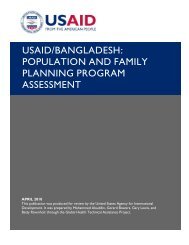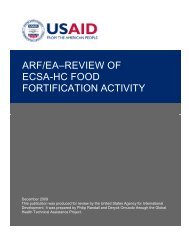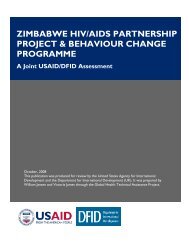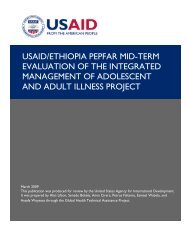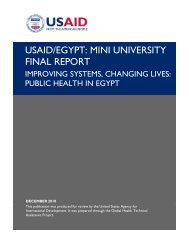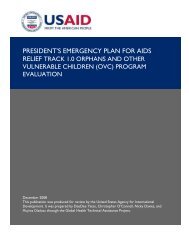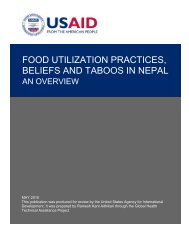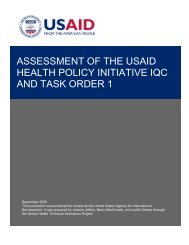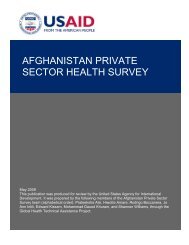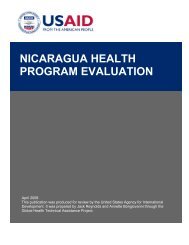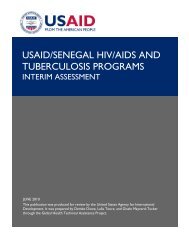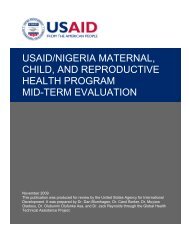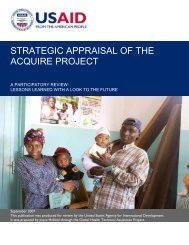Evaluation of the Tuberculosis Control Assistance Program (TB CAP)
Evaluation of the Tuberculosis Control Assistance Program (TB CAP)
Evaluation of the Tuberculosis Control Assistance Program (TB CAP)
You also want an ePaper? Increase the reach of your titles
YUMPU automatically turns print PDFs into web optimized ePapers that Google loves.
– Integrate <strong>TB</strong> control efforts within primary health care services more effectively;– Develop or streng<strong>the</strong>n linkages between <strong>TB</strong> control programs and HIV/AIDS prevention andtreatment programs, and MDR-<strong>TB</strong> prevention and control efforts;– Disseminate <strong>the</strong> objectives <strong>of</strong> <strong>the</strong> <strong>TB</strong>CTA to USAID missions and <strong>the</strong> countries selected; and– Expand <strong>the</strong> capacity for providing high quality technical assistance worldwide.Within <strong>TB</strong>CTA a special group, Task Force Training (TFT), had been established to address <strong>the</strong> humanresource development issues. Under <strong>TB</strong> <strong>CAP</strong>, TFT was broadened and changed to have a differentstructure to include a forum for HRD beyond <strong>the</strong> project. The task force was turned into a working groupon HRD and a broader <strong>TB</strong> HRD platform network and meeting was created to provide input from <strong>the</strong>countries and partners with experience in developing human resources across <strong>the</strong> health sector andbeyond. An online forum is available to maintain <strong>the</strong> network. In addition, two institutions in developingcountries were competitively chosen to build regional institutional capacity.Currently, <strong>TB</strong> <strong>CAP</strong> has received field support from 31 USAID countries: Afghanistan, Bangladesh,Botswana, Brazil, Cambodia, 5 Central Asian Republics (CAR), Djibouti, Dominican Republic, DRCongo, Ethiopia, Ghana, Indonesia, Kenya, Malawi, Mexico, Mozambique, Namibia, Nigeria, Pakistan,Philippines, Russia, Sudan, South Africa, Uganda, Vietnam, Zambia, and Zimbabwe. Each countryfocuses on different gaps in <strong>the</strong> <strong>TB</strong> control program that need streng<strong>the</strong>ning to reach <strong>the</strong> global targets. Inaddition, <strong>TB</strong> <strong>CAP</strong> has received field support from <strong>the</strong> Africa Bureau, Latin American and CaribbeanBureau, Europe and Eurasia Bureau, East Africa Regional Mission, and Guatemala Central American<strong>Program</strong> (G-<strong>CAP</strong>). Lastly, <strong>the</strong>re are funds from <strong>the</strong> GH Bureau in Washington for core-funded activities.III. PURPOSEThe purpose <strong>of</strong> <strong>the</strong> evaluation is to comprehensively review <strong>the</strong> performance, impact, and lessons learned<strong>of</strong> <strong>the</strong> <strong>TB</strong> <strong>CAP</strong> project collectively, in <strong>the</strong> different technical intermediate results (IRs), and in individualcountries against <strong>the</strong> goals and objectives set for <strong>the</strong> project as well as its contribution to <strong>the</strong> goals andobjectives <strong>of</strong> <strong>the</strong> Stop <strong>TB</strong> Partnership in a collaborative, efficient, and cost-effective manner. Theevaluation should break down and analyze common factors or patterns for success or areas forimprovement in <strong>the</strong> specific objective outlined below. The team will look retrospectively at <strong>the</strong> <strong>TB</strong> <strong>CAP</strong>cooperative agreement activities since inception and answer <strong>the</strong> principal questions: What is <strong>the</strong> evidencethat <strong>TB</strong> <strong>CAP</strong> has made or will have made accelerations on <strong>the</strong> pace <strong>of</strong> DOTS expansion toward reaching<strong>the</strong> global targets and building institutional and individual capacity for <strong>TB</strong> control in targeted countries?In addition, is this <strong>the</strong> optimal framework and setup for a multifaceted mechanism with an array <strong>of</strong>partners within <strong>the</strong> Stop <strong>TB</strong> Partnership, taking into consideration USAID’s comparative advantages?The results will be used to provide feedback to <strong>TB</strong> <strong>CAP</strong> on project operations and management andprovide recommendations to <strong>TB</strong> <strong>CAP</strong> and USAID on improving implementation. In addition, <strong>the</strong>evaluation will inform USAID in <strong>the</strong> future design <strong>of</strong> <strong>TB</strong> activities.IV. SPECIFIC OBJECTIVES AND ILLUSTRATIVE EVALUATION QUESTIONSOverarching IssuesWhat are <strong>the</strong> overall lessons learned and best practices from <strong>the</strong> Coalition?Is <strong>the</strong> sum <strong>of</strong> <strong>the</strong> Coalition greater than <strong>the</strong> individual parts? What specific synergies have developedbecause <strong>of</strong> <strong>the</strong> Coalition? Has <strong>the</strong> Coalition been advantageous to USAID, each <strong>of</strong> <strong>the</strong> partnersindividually, and <strong>the</strong> broader <strong>TB</strong> community?Is <strong>TB</strong> <strong>CAP</strong> contributing to <strong>the</strong> coordination <strong>of</strong> partners and global leadership at different levels?42 EVALUATION OF THE TUBERCULOSIS CONTROL ASSISTANCE PROGRAM (<strong>TB</strong> <strong>CAP</strong>)



